
How to Store Seeds Long Term: Essential Techniques and Best Practices
Author: Jo Wells
Last Updated: February 13, 2023
[*]Before storing seeds long term, first and foremost you need the right kind of seed. You also need proper air, light, and temperature.
We’ll explain everything you need to know from start to finish about storing and using seeds long term, so you’re sure to have a bountiful season for years to come.
The Right Seeds for Long-Term Storage
Imagine your disappointment when all your hard work produces little to no crop yield because your seeds were duds. It’s important to understand that not all seeds are created equal, and some seeds won’t produce the way you want them to.There are essentially six terms to know when it comes to garden seeds.
- Hybrids
- Heirlooms
- Treated
- Open-pollinated
- Organic
- GMO
Hybrid Seeds
[*]

[*]Nisetpdajsankha, CC BY-SA 3.0, via Wikimedia Commons
Remember Mendel’s pea plants from science class? That’s hybrid seeds in a nutshell. They’re the result of cross-pollinating different seed varieties within the same species. These intentionally altered seeds produce the following benefits:
- Better disease resistance
- More uniformity
- Higher overall yield
- Easier harvesting
- Less labor
Unopened or leftover seed packets may be salvageable for as long as they are viable, assuming they’re stored properly.
However, don’t waste time collecting seeds from these plants. Manufacturers design these seeds for single use. Anything beyond the first generation becomes unstable because these “first children” plants rarely produce the same fruit as their parent plant.
You could get anything from no food production to food with poor quality, texture, and taste. Or anything in between. Furthermore, the quality substantially decreases from one generation to the next.
[*]
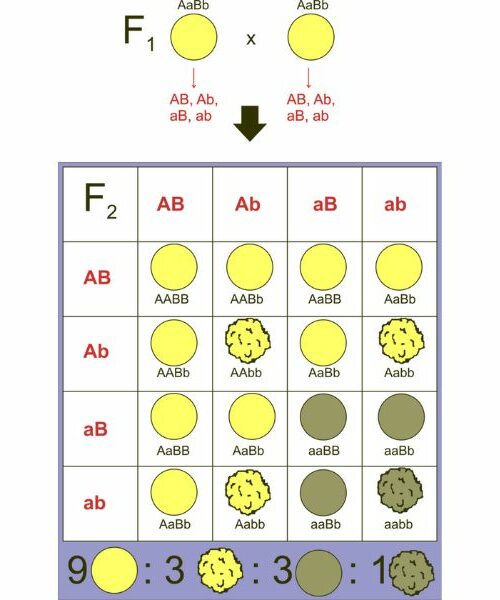
[*]Miguelferig, CC0, via Wikimedia Commons
While there are successful stories of planting these F1 offspring, it’s truly the seed companies and commercial growers that reap the benefits of hybrid seeds. Most seed savers agree the risk of storing them is hardly worth it.
Heirloom Seeds
Heirloom seeds are the caviar of gardening. Their antiquity of more than 50 years makes them the coveted blue-ribbon winner. Generation after generation passes these seeds down like old family recipes. Farmers and gardeners alike recommend heirloom seeds far more than any other.Heirloom seeds are a type of open-pollinated plant that produces resilient crops. They are known for retaining the desired qualities of their parent plants, including flavor, yield, and resistance to pests, disease, and inclement weather.
Whether you’re saving seeds from the original packet or their offspring, heirlooms are definitely the way to go.
Treated Seeds
Manufacturers sometimes treat seeds with harsh chemicals, such as pesticides and fungicides. Most self-reliant people shy away from chemically treated seeds because of possible health concerns. However, that’s not to say [url=https://agcrops.osu.edu/newsletter/corn-newsletter/201918/how-store-treated-seed#:~:text=Interestingly%2C in this set of experiments the treated,same or were unaffected by the seed treatment.]treated seeds[/url] can’t reproduce viable crops.Open-Pollinated Plants
You may notice some seed packets labeled ‘OP’ or ‘open-pollinated.’ It simply means these seeds germinate naturally, and their offspring produce a similar type. While heirloom seeds are considered open-pollinated, most hybrid seeds are not.Organic Seeds
In layman’s terms, organic farms with government certification produce organic seeds. It guarantees that synthetic fertilizers, herbicides, or pesticides have not tainted those seeds. Additionally, it ensures they are not genetically modified.Hybrid, open-pollinated, and heirloom seeds can all be categorized as organic if they meet the criteria. On the other hand, genetically modified and treated seeds cannot.
GMO Seeds
GMO seeds are a beast of their own. The science behind bioengineered food is quite complex, but genetically modified seeds are produced in a lab using recombinant DNA technology to merge DNA from different animals and plants together.While GMO foods plague your grocery store shelves, you’ll likely never find GMO seeds or plants on a store shelf. They are typically reserved for commercial farmers and large-scale farming operations.
Most seed and nursery companies sign the Safe Seed Pledge certifying their wares are free from genetic modification or bioengineering. So, if you have any doubts, just ask.
To ensure you’re getting the healthiest, most-abundant crops year after year, here are the best seeds to save:
- Organic
- Heirloom
- Open-pollinated
- Non-GMO
- Non-hybrid
- Non-treated
Collecting Seeds for Long-term Storage
When it comes to long-term seed storage, knowing when to collect your seeds is of the utmost importance. Contrary to what one might think, when your garden food is perfect for eating, your seeds are not quite mature enough for collecting.Harvest corn, bean, and pea pods after they have dried on their stalks. For fruits like bell peppers, tomatoes, cucumbers, and melons, the Illinois Extension recommends leaving a few fruits on the plant until they are overripe and sour.
As the food becomes inedible, the seeds mature enough for harvesting. Mature seeds are usually full and round, while unviable seeds are typically flat or green.
When collecting seeds from your annual garden, gather several from each crop throughout your gardening season. Seeds need to be thoroughly dried first, which takes time. This may be easier to do in smaller batches rather than all at once.
If you’re saving seeds from pulpy crops, such as tomatoes or cantaloupe, wash the pulp off before drying them. You can do this by rinsing them in a container filled with water. You can also wash them by hand. I usually just place them in a strainer and rub them between my fingers until they’re clean.
Drying Seeds for Long-term Storage
Wet seeds can mold, sprout, rot, or suffer frost damage. So, it’s imperative you dry them completely before packing and storing them. There are several different methods for doing this, but here are the most common.Air Drying
Spread your seeds on a dish, coffee filter, or parchment paper in a well-ventilated area to air dry. While smaller seeds may dry in as little as 24 hours, larger seeds sometimes take up to three weeks.Stir seeds at least once a day and flip larger seeds, so they dry evenly. Seeds can appear dry on the outside but still contain moisture on the inside. Once you think they’re dried, perform a snap test (explained below) to be sure.
Some seed savers use additional methods for drying, but air drying is by far the most efficient and safest method to avoid killing your seeds.
Dehydrating
If you’re going to use a dehydrator, it must have a low enough temperature setting to set between 80 and 90 degrees Fahrenheit.Additionally, you should only use dehydrators for larger seeds, such as beans, pumpkins, and squash. Because smaller seeds can be overheated and cooked, they shouldn’t be placed in a dehydrator.
Likewise, you shouldn’t run your dehydrator for more than 30 minutes at a time since this could accidentally cook your seeds.
Don’t use an oven to dehydrate seeds. Ovens cannot achieve the low temperatures necessary to avoid overheating the seeds.
Fans
You can also use electric fans to assist in air-drying seeds. To prevent seeds from blowing away, some people trap the seeds between air conditioning filters. Others place seeds between two coffee filters or pieces of cheesecloth and hold them in place with a cross-stitch hoop. You can also place the seeds between fine mesh wire screens.[*]
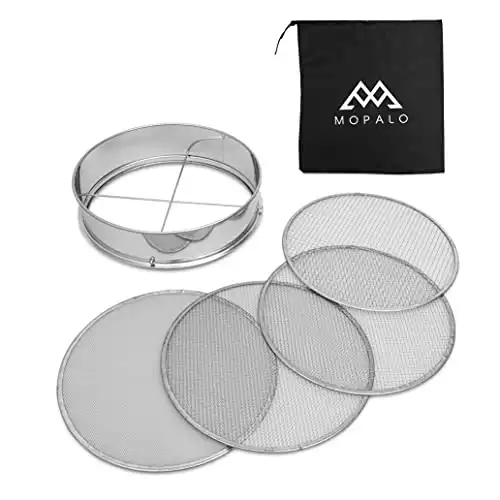
Whatever method you choose, arrange your fan and seeds so air can blow through your filter, cheesecloth, or screens for maximum coverage. Small seeds dry rather quickly, but larger seeds may require a week or more.
Make sure you keep plenty of space between your seeds or stir them frequently to prevent mold and rot.
Check and Package Your Seeds
[*]

[*]Once you feel your seeds are dry, perform a snap test. To do this, attempt to break one of your seeds in half. If you succeed, it’s dry enough for storage. However, if it’s soggy or if it bends, continue drying.
There are a variety of ways to package your seeds:
- #1 coin envelopes
- Ziplock bags
- Mylar bags
- Repurposed baby food jars, small food jars, or pill bottles
- Mason jars
Packing in smaller quantities works best, but that’s personal preference. Regardless of which packaging you choose, don’t forget to label your seeds with their name and the date you collected them (origination date).
[*]
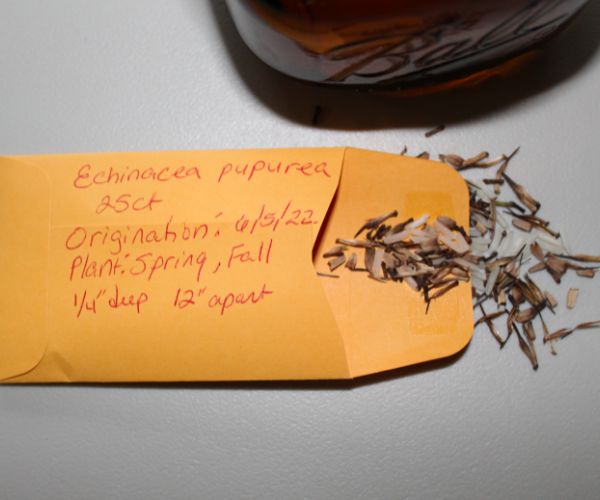
[*]Feel free to add any additional information you deem pertinent, such as seed count or planting instructions. As with all things storage, rotate your stock on a first-in, first-out basis.
Organizing Your Seeds
If you’ve gardened for any length of time, you know staying organized makes life a lot easier. Organizing your seed stock is no different. Two popular methods among avid gardeners include catalogs and mason jars.Catalogs
To catalog your seeds, you can organize them by alphabetical order, month, origination date, plant date, or any other means that suits you. Once you’ve grouped all the seeds by your preferred method, place labeled dividers between them to differentiate one group from the next.You can place them in one large container so they’re all together. Some gardeners use seed storage boxes or seed banks, while others use trading-card boxes or even old shoe boxes.
Mason Jars
Mason jars are a nifty way to categorize your seeds by themes. For example, I like storing all my herb seeds in a single mason jar for easy access since I plant them several times throughout the year.After placing the seeds in #1 coin packets and labeling them, I just drop them into a dark mason jar for air-tight storage.
[*]
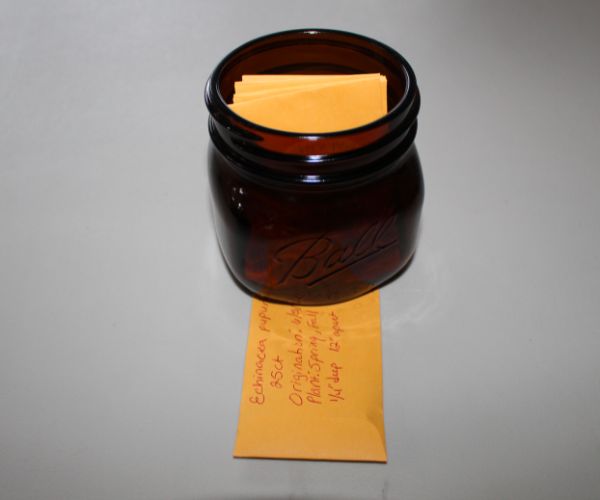
Protecting Your Seeds for Long-Term Storage
Moisture, temperature, light, and pests can all ruin your seeds over time. Here’s what you need to know.Moisture
Excessive moisture causes the outer seed wall to become soft. This can cause the seed to split open, mold, or rot. Moisture can also cause your seeds to sprout, rendering them useless.Silica gels are an ideal way to prevent moisture from infiltrating your seeds. Likewise, dried rice grains also stave off moisture. Tossing either in with your seeds adds an extra layer of protection.
Temperature
In order to prevent the risk of premature germination, temperatures must be kept below 60 degrees. Anything higher, and you’re risking the dormancy of your seeds, which will cause them to degrade quickly.It’s recommended you keep them below 40 degrees Fahrenheit for successful long-term storage. Consider placing your seeds in one of the following:
- A basement
- A cold closet
- The north side of your home
- The freezer
- An electrical beverage cooler
Experts debate the benefits of freezing seeds long term because of the considerable risks:
- Subfreezing temperatures can kill the embryos of some plants.
- If the power goes out, temperature fluctuation could kill the seeds.
- Once you remove seeds from the freezer, you can’t put them back in.
- Some argue your freezer opens and closes too much to maintain a constant temperature for good preservation.
- Freezers are prone to condensation.
Only you can weigh the risks versus the rewards. However, should you opt for freezer storage, you’re better off storing smaller quantities for shorter periods of time.
I’m always a proponent of having more than one source for anything. For any prepper, three is two, two is one, and one is none. Consider storing a small amount of seed in your freezer and a larger amount elsewhere.
Some recommend using a small beverage cooler that can be tucked away somewhere and only accessed when you’re pulling seeds. However, the same risks apply for both moisture and power outage.
Light
Plants feed on sunlight, so prolonged exposure to light encourages them to germinate and sprout. Light also causes your seeds to decay.A small amount of light is not overly harmful, but the longer you plan on storing your seeds, the more concerned you should be. For best results, store seeds in dark or opaque containers to significantly limit their exposure.
If you use ziplock bags or clear jars, you should house those in dark containers or locations.
Pests
Pests can destroy your precious seed supply just as quickly as they can destroy your garden. If insects so much as nibble on your seeds, there’s little chance they will germinate. Watch out for these common culprits:- Beetles
- Mice
- Moths
- Weevils
- Roaches
The best way to prevent bugs from attacking your seed supply is to place oxygen absorbers in your containers so they can’t survive. For larger critters, like roaches and mice, choose durable, airtight containers that rodents can’t chew through.
Sometimes double-layering is the safest measure to ensure adequate protection.
How Long Do Stored Seeds Last
Over time, seeds decay regardless of how well you preserve them. The longevity of seeds varies from crop to crop.Generally speaking, annual flower seeds last for 1–3 years, while perennials last for 2–4 years. Vegetable seeds contain a lot of natural oils, so the oilier the seeds, the shorter the shelf life.
Because alliums, corn, parsnips, and spinach contain a higher oil content, you should replace these seeds annually.
When purchasing garden seeds, in many cases, you’ll see an expiration date on the package. If you have expired seeds in your possession, you can still use them (if they are viable) without worrying about any negative impact on your food.
[*]
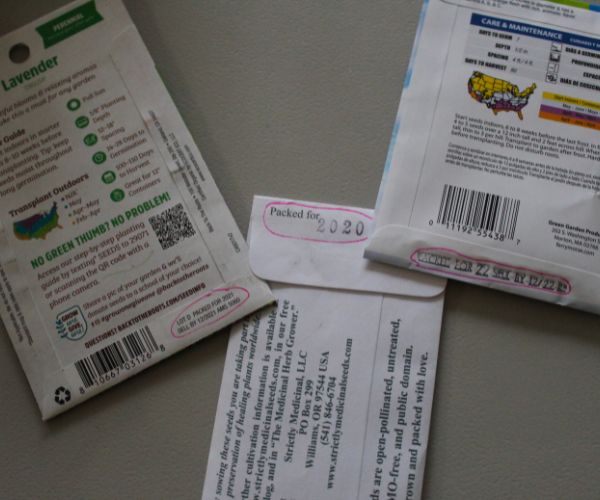
You can perform a germination test to determine their viability. When seeds “go bad,” they don’t produce bad food, they just won’t grow.
Here is a basic guideline for the longevity of common seeds.
Seeds That Last 1–2 Years
- Beets
- Beans
- Chives
- Corn
- Dandelion
- Garlic
- Lentils
- Onions
- Okra
- Parsley
- Peppers
- Spinach
Seeds That Last 3–4 Years
- Asparagus
- Broccoli
- Brussel sprouts
- Cabbage
- Carrots
- Cauliflower
- Celery
- Collards
- Cucumbers
- Fennel
- Lavender
- Lettuce
- Melons
- Peas
- Radishes
- Squash
- Tomatoes
- Turnips
- Watermelon
- Kale
Seeds That Last 5–6 Years
- Arugula
- Basil
- Mustard Greens
- Radishes
If you’re continually rotating your seeds after each gardening season, you really don’t need to save seeds for more than five to six years. As time goes on, just like other foods, their quality degrades and their viability declines.
There’s no point in saving seeds that won’t produce food.
Survival Seed Kits
Don’t fall for the 25-year, zombie apocalypse, regrow-the-world scenario. It’s simply not practical. Mother nature intended seeds to be in the ground, not stored indefinitely. Even most essential seed bank kits come with an average shelf life of five years or so unless they’re placed in the freezer.Even still, while they promise you 20+ years, this is only under the most ideal situations and won’t apply to every seed type. No matter the type of seed and its variety, or how and where you store it, each year that a seed is in storage deteriorates it. Expect a 5%–20% lower quality with each year of storage.
It’s still a good idea to keep a survival seed kit. It’s just better practice if you continually rotate your seeds. The younger the seed, the longer its viability.
Removing Seeds From Cold Storage
When using cold storage, make sure you allow your seeds to reach room temperature before opening them. Otherwise, they may absorb condensation while thawing, potentially ruining your entire stash.A good rule of thumb is to let them rest on the counter for a minimum of 12 hours before opening the container.
Why You Should Store Seeds Long Term
The benefits of storing seeds are numerous, but ultimately it makes you more self-sufficient and saves you money in the long run. Buying seeds and starter plants every year can get quite expensive.Have another look at the benefits of heirloom seed storage:
- Extending your harvest season
- Ensuring you aren’t eating GMO foods or foods heavily contaminated with herbicides, pesticides, and fungicides
- Ensuring your crop viability
- Decreasing seed-borne diseases
- Promoting natural resistance against pests
- Preventing waste of unused seeds
- Taking advantage of seed sales
- Facilitating a seed bank or survival garden
Storing and using your garden seeds properly is the best way to ensure you have food on the table year after year.
THANKS TO: https://www.primalsurvivor.net/store-seeds/?utm_source=ActiveCampaign&utm_medium=email&utm_content=From+Plot+to+Plate&utm_campaign=Determining+the+Right+Amount+of+Crops+for+a+Year+s+Supply+of+Food&vgo_ee=Q%2FkOcp8n28z76UtQViPR6dDJ6KJG6%2Bzyv3yPHo%2FhPvTJU%2F%2BcVHk7brs%3D%3AkYlqROcGZRvI6sEQ2Sl1ptnYeqrrvwiI






 Sat Mar 23, 2024 11:33 pm by globalturbo
Sat Mar 23, 2024 11:33 pm by globalturbo

